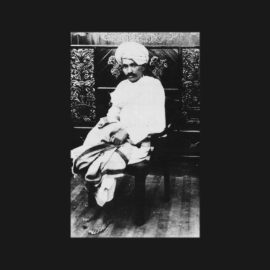

This article is an excerpt from the Shortform book guide to "The Story of My Experiments with Truth" by Mahatma Gandhi. Shortform has the world's best summaries and analyses of books you should be reading.
Like this article? Sign up for a free trial here.
How much do you know about the life and philosophy of one of history’s most influential leaders? What drove Mahatma Gandhi’s pursuit of truth and nonviolence?
Mahatma Gandhi’s autobiography, The Story of My Experiments With Truth, offers a glimpse into his journey from childhood to political activism. It explores his search for justice, his practice of nonviolence, and his leadership in India’s struggle for independence.
Read more to learn Gandhi’s life story and discover the principles that shaped his legendary activism.
Overview of The Story of My Experiments With Truth
The Story of My Experiments With Truth is Mahatma Gandhi’s autobiography. It covers his life from childhood to 1921, as he took center stage in India’s struggle for independence from the British Empire. (Shortform note: India gained independence from the British Empire on August 15, 1947, after decades of nonviolent activism and negotiations between the Indian National Congress—which Gandhi led for several years—and the British government.)
The title of Gandhi’s autobiography refers to his search for justice and morality, or what he calls “Truth” with a capital “T.” To Gandhi, Truth was the only god—the supreme and unchanging foundation of morality and justice. His search for Truth led him to practice nonviolence and to lead an austere lifestyle renouncing sex and indulgent food.
Gandhi’s nonviolent activism in his struggle for Indian rights and independence made him a legendary figure. His autobiography provides a peek behind the curtain as he explains his thinking behind nonviolence, his lifestyle choices, and the relationship between India and the British Empire. He wrote this book in installments, which he published in his journal Navajivan to explain to his followers his beliefs and how he’d come to them. (Shortform note: The publication of Navajivan was a central element in Gandhi’s activism. He used the weekly journal to educate his fellow Indians on the principles of nonviolence and to explain his decisions when critics questioned them.)
Our overview begins by further exploring Gandhi’s concept of Truth and how he pursued it through nonviolence and austere life choices. Then, we’ll discuss Gandhi’s life story and the origins of his beliefs, from his childhood to his first political actions in India. We’ll end by describing his political leadership for India’s home rule or Swaraj: self-government without the interference of the British government.
Gandhi’s Experiments With Truth
Gandhi’s public actions as a political leader and nonviolent activist expressed a private concern: his constant search for justice and morality, or Truth. He argues that he devoted his life to pursuing Truth because it was the only certainty in an uncertain world, and it gave him peace of mind to know that he was always striving for it. We’ll explain Gandhi’s efforts to discover Truth through ahimsa (nonviolence) and brahmacharya—the pursuit of enlightenment through purity.
Nonviolence (Ahimsa)
Gandhi believed that one could only reach Truth through nonviolence or ahimsa because violence was antithetical to Truth. Gandhi explains that humans can’t avoid causing harm—himsa—to others. For example, we harm animals and plants to eat, and we participate in societal himsa, like war.
We’ll first discuss how for Gandhi, practicing ahimsa meant being kind and not harming living beings. Next, we’ll explore how Gandhi handled a situation when it was impossible to be completely free from himsa.
Practicing Ahimsa
Gandhi sought to practice nonviolence in every aspect of his life, including the following ways:
Nursing the sick and wounded
Gandhi enjoyed taking care of others. He believed this service should be provided gladly—not by obligation. He happily nursed family members and strangers when they were sick or hurt.
Not harming insects or dangerous animals
Gandhi believed in protecting the lives of all living creatures. For example, he founded an ashram, a home for families who wanted to practice ahimsa and live simply off the land. There were snakes on the land, but he never allowed anyone to kill them, even though they lived in tents with young children while they built their houses. The snakes never bit them, which Gandhi attributed to God’s protection.
Being a strict vegetarian
Safeguarding animals also meant not eating meat. Gandhi was raised vegetarian, and he later decided to stop eating eggs—which he equated to eating meat. He also stopped drinking milk due to the violent way farmers extracted it from animals.
Dilemmas of Ahimsa
Despite his profound commitment to ahimsa, Gandhi admits his efforts were imperfect. For instance, he describes the challenges of practicing ahimsa when volunteering for the British Empire’s ambulance service during the South Africa War and World War I.
Gandhi explains that he was caught between two duties: pursuing ahimsa and improving the situation of his people. Pursuing ahimsa would’ve meant trying to stop the conflict, which he felt he wasn’t strong enough to do. Simply staying out of the conflict wouldn’t count as practicing ahimsa because, by living under the protection of the British Empire, he was already participating in its violence.
Since he was already involved in the himsa, he used the opportunity to further his goals for India. He believed that volunteering in the war would help him improve the situation of the Indian people. At that time, he thought that being part of the British Empire was good for India and that the British government would treat Indians better if they supported the war.
Brahmacharya
In addition to believing in nonviolence, Gandhi believed that having a pure mind and body was necessary to find Truth. A mind and body contaminated by harmful thoughts or elements, such as lust or meat, was more likely to commit violence, and therefore less likely to find Truth. Self-purification led him to brahmacharya—the pursuit of enlightenment through purity. Gandhi strived for self-purification through monogamy, celibacy, and diet, all of which he believed would help keep his body and mind clean and open to Truth.
Monogamy and Celibacy
Gandhi expresses his commitment to being a loyal husband to his wife, Kasturbai. However, he admits to having moments of being attracted to other women, which he felt deep shame about. He believes God intervened each time to save him from acting on the attraction. However, he explains that his commitment to being a loyal husband turned into jealousy. In the early years of their marriage, he was possessive and controlling.
His monogamy gradually became celibacy. After 18 years of marriage, he began practicing self-restraint to avoid having intercourse with his wife. At first, he wanted to prevent having more children because his activism was incompatible with family life. Five years later, he took a celibacy vow, which he described as freeing because it defended him against temptation. His self-restraint also helped his relationship with Kasturbai. Gandhi stopped seeing his wife as a sexual object, which helped him appreciate her personhood more fully.
Diet
Gandhi believed that controlling the quality and quantity of his food was as crucial for spiritual enlightenment as controlling his sexual desires. At first, his dietary choices were motivated by health concerns, but later they were influenced more by his philosophical beliefs. As a result, his diet leaned more toward fasting and restrictions:
- He avoided alcohol all his life.
- After being a vegetarian for many decades, he adopted a fruitarian diet. Later, he felt that this diet was too enjoyable and that eating should focus only on bodily sustenance.
- When he was imprisoned for refusing to comply with an unfair law in 1908, he realized that the rules for inmates—for example, they couldn’t have tea, coffee, and condiments—fit well with his brahmachari lifestyle. After his release, he continued following these restrictions.
- Following his mother’s example, he began fasting regularly. He believed that fasting tamed the senses, purified his mind, and made it easier to practice celibacy.
Gandhi’s Life
Gandhi’s autobiography traces his story from his childhood in Porbandar, India, to his rise as a leader in the independence movement. Throughout his story, he develops his values and constructs his philosophy of seeking Truth through nonviolence and purity, culminating in putting those values and beliefs into practice through his activism.
Childhood in India
We’ll recount Gandhi’s early years in India. We’ll further explore some of the formative events of his childhood and teenage years, including his marriage at age 13 and his time spent nursing his sick father.
Growing up in Porbandar
Mohandas Gandhi was born in 1869 in Porbandar, India. He explains that his parents’ religious faith and values profoundly influenced him. For example, his mother, Putlibai Gandhi, impressed her son with her religious commitment to vegetarianism and fasting. When it was time for Mohandas to leave the family home for university, she wouldn’t let him go without vowing not to eat meat, drink alcohol, or have sexual relations—practices which Mohandas continued throughout his life.
Although Mohandas claims that he was unremarkable as a child, the makings of his future leadership were already there. Although he was shy, struggled to make friends, and didn’t achieve great results at school, he developed a strong sense of duty early on, as well as a commitment to honesty—a precursor of his search for Truth. For example, he read a book about devoutness to one’s parents that deeply affected him and made him wish to be a deeply devoted son, just like the main character of the story. He also saw a play that instilled in him the virtue of truthfulness. He remembers imagining himself as the main character, upholding truth at all costs—both the truth of a situation and the Truth within oneself.
Getting Married at 13
Mohandas was married at 13 to a girl called Kasturbai. Reflecting on this later as an adult, he realized that the adults around him failed him when they made him get married at such a young age, and he was glad that the children in his family didn’t have the same experience.
Kasturbai was a quiet and self-sufficient girl who hadn’t received any education. Mohandas says he wanted to teach her, but he was distracted by lust for her during the first years of their marriage. When that distraction wore off, he got involved in public service, which kept him from having time to teach Kasturbai anything beyond basic literacy.
Teenage Years
As a teenager, Gandhi further developed key values that would guide him as an adult: honesty, nonviolence, duty, and self-restraint. Two events show these values taking shape.
Honesty and Nonviolence
Mohandas and some of his friends experimented with smoking and eating foods that their parents forbade. In the process, they racked up debt at a local store and Mohandas stole gold from his brother to repay the debt. Later, he felt guilty and wrote a letter to his father confessing. Instead of punishing him, his usual response to misbehavior, his father ripped up the confession and hugged him. Mohandas believed and admired that his father responded with love instead of violence because he knew that Mohandas’s confession came from true regret.
Duty and Self-Restraint
When Mohandas was 16, his father became ill. He was happy to be his father’s nurse, but Mohandas often felt impatient to return to his wife’s room to have sex, which caused him shame. The night his father died, Mohandas was with his wife. Mohandas says he deeply regretted that lust kept him from being with his father in his final moments.
Law School in England
We’ll discuss Gandhi’s life after he finished high school, including his three years studying Law in London.
Making It to England
In 1887, Gandhi finished his high school education but wasn’t sure about his next steps. A family friend suggested that he go to England and study law. This would secure him a high-earning and respectable career. Gandhi says he felt both scared and thrilled at the idea of going abroad. But two major obstacles stood in the way:
First, Putlibai didn’t approve of her son living abroad for several years. She was worried that he’d be tempted to drink alcohol, eat meat, and have relationships with women. To calm her fears, Mohandas took an oath to abstain from those vices and she gave him her blessing.
Then, the caste Gandhi’s family belonged to forbade him to travel because they followed religious prohibitions against foreign travel. He decided to go despite their prohibition, and the caste expelled him from the group.
Life in England
Once in London, Gandhi remembers that he continued to face formative challenges. Those challenges included:
Finding vegetarian meals. Gandhi says he often starved because he couldn’t get filling vegetarian meals in London. He also had to defend his decision whenever people insisted he eat meat. He eventually found vegetarian restaurants and learned to cook.
Living on a tight budget. He spent a lot of money trying to fit into London society, including investing in an entirely new wardrobe. However, he soon had to cut back. He moved to a modest apartment, began walking instead of using public transportation, and took meticulous notes of all the money he spent. These habits stayed with him all his life.
Early Career in South Africa
We’ll describe the time after Gandhi completed his legal training. He passed his Law school exams on June 10th, 1891, and he was on a ship back home by the 12th. He eventually found work in Natal, a province in South Africa. This is where he had his first experiences of discrimination and began his activism career defending the rights of Indians.
Moving to South Africa
Back in India, Gandhi didn’t have much success as a lawyer. He was shy and felt uncomfortable charging his clients for his work. His brother, who’d paid for his education, worried that Gandhi couldn’t contribute to the family’s finances.
Amid these worries, Gandhi received a job offer in South Africa from one of his brother’s wealthy business partners. The job was to provide legal counsel to an Indian-owned company. The offer was enticing: It paid well and offered the chance to leave India and have new experiences.
Despite his excitement for this new adventure, Gandhi says he was sad to say goodbye to his wife once again, especially as they’d welcomed their second baby since his return from England. So, when he set off to South Africa in April 1893, he was filled with both excitement and sadness.
Experiencing Racism
Gandhi’s experience in South Africa was eye-opening. He experienced racism as an immigrant of color in a European colony. He narrates several noteworthy experiences, including:
- Suffering discrimination on the train. Due to his race, Gandhi couldn’t travel first class. On his first train trip, he was kicked off the train for complaining. He completed the trip by coach, and the coach leader hit him when he refused to sit outside.
- Being referred to as a “coolie barrister.” The Indian community was made up of several cultural, geographic, and religious groups, but the Europeans referred to all Indians as “coolies,” a derogatory term for Indian laborers.
Starting Public Work
Gandhi’s experiences of discrimination led him to become an activist for Indian national dignity. During his time in South Africa, he became a leader of the Indian community. After seeing they were divided along religious and ethnic lines, he advocated for coming together as Indians. He proposed establishing the Natal Indian Congress to bring the problems Indian settlers faced to the authorities, and he volunteered his time and effort for this cause.
These are two of the key moments of Gandhi’s leadership journey in South Africa.
The Natal Franchise Bill
In 1893, the Natal Legislative Assembly proposed the Franchise Bill to take away Indians’ voting rights. Gandhi and his friends drafted a petition and collected signatures opposing the bill. It passed, but Gandhi argues that their resistance united the Indian community in their commitment to defending their political rights.
The £25 Tax
In 1894, Gandhi advocated for the rights of Indian indentured laborers in South Africa. These laborers were taken to South Africa to work in sugarcane farming on five-year contracts, after which they were free to do other work and purchase land. Many had become independent farmers and merchants. However, Gandhi says that the Europeans in South Africa resisted their competition in trade and rejected the Indians’ lifestyle, from their hygiene habits to their religion.
To stop former indentured laborers from working freely in Natal, the government enforced a yearly tax of £25 on any contracted Indian laborers who stayed in South Africa to work independently. After the Natal Indian Congress campaigned against the tax, the government reduced it to £3.
Political Leadership in India
Gandhi’s experiences in South Africa prepared him to become a national leader in his country. He returned to India as a well-known defender of Indian rights. He defended farmers, laborers, and other disadvantaged groups from the British government’s unfair treatment. Over time, he says, these experiences changed his views on the British Empire, and he began to see independence as the only way for Indians to achieve their rights.
We’ll explore some of the highlights of Gandhi’s political leadership, which demonstrated his commitment to the nonviolent pursuit of Truth. Gandhi founded the Satyagraha movement—nonviolent resistance to the British Empire’s oppression of Indians. Satyagraha (from the Sanskrit words sat, meaning truth, and agraha, meaning steadfastness) involved resisting unfair or immoral situations through nonviolent action. The nonviolent actions he endorsed were mostly disobeying laws in a way that didn’t endanger or harm anyone.
Champaran Satyagraha
In 1917, Gandhi conducted his first satyagraha campaign in India. He met Rajkumar Shukla, a farmer from the Champaran region who shared that the British indigo planters were exploiting them. Gandhi was initially hesitant to take up the cause of the farmers who were forced by the planters to grow indigo on their land. He finally decided to travel to Champaran and conduct his investigation after much insistence from Shukla.
The Champaran Satyagraha involved different levels of nonviolent action. First, with his team of activists, Gandhi questioned hundreds of farmers to identify the injustices taking place. He also met with the planters to hear their side of the story and understand their needs. At the same time, he organized volunteers to provide education, medical care, and sanitation services for the farmers.
Many planters weren’t happy with Gandhi’s investigation, and they lobbied the government to pressure Gandhi to leave Champaran. He refused to leave unless the government began an official investigation into the farmers’ complaints. Gandhi continued his inquiry despite opposition and faced a court summons for violating an order to stop the investigation. Gandhi’s trial marked the first instance of civil disobedience—the refusal to comply with unfair laws—in the country and increased his popularity among the peasants.
Finally, the governor instituted a committee to investigate and invited Gandhi to be a member. The committee’s findings favored the farmers, and the abusive system the planters had used until then was abolished. This victory cemented Gandhi’s stance as a national leader.
Kheda Satyagraha
In 1918, Gandhi led a satyagraha movement in the Kheda district of India. Crops had failed and there were widespread famine and plague epidemics. The farmers or ryots asked the government to cancel the year’s tax since they hadn’t made a profit, but all their petitions failed.
Gandhi traveled to Kheda and led the farmers in a satyagraha resistance in which they refused to pay their taxes despite the government considering it illegal. Even those who could afford to pay promised not to, in solidarity with the farmers most affected by the failed crops. In response, the government pressured the farmers by taking away their agricultural machinery.
Gandhi says that after several months of resistance, they needed to find a resolution that would allow both sides not to lose face. He negotiated with the government to allow the poorest farmers not to pay their taxes but still collect from the ones who could afford to pay. Although it wasn’t a total victory, Gandhi still felt that the effort had been worthwhile because it showed the farmers that they had political power they could use to fight injustice.
The Amritsar Massacre
In 1919, the people of India were eager for independence. Gandhi explains that the nonviolent movement for national dignity was growing, but not everyone understood the principles of nonviolence. In Amritsar, which is located in the Punjab region of India, the people’s desire for justice and respect reached a boiling point. There were frequent confrontations between them and the government forces, which responded with unrestrained violence.
Gandhi’s response to the Amritsar Massacre exemplified his commitment to satyagraha and to uncovering Truth. Other leaders urged Gandhi to go to Amritsar soon after the massacre—but the government forbade him, which further enraged the population. Instead of traveling to the Punjab despite the prohibition, Gandhi decided to wait. He knew the people were looking to him for leadership, and he believed that if he had taken bold action, the people of Punjab would have used that as a cue for more violent resistance.
Instead, he had multiple conversations with government officials and showed them that allowing him to be there to engage with the people would help bring peace to the situation. Eventually, the government allowed Gandhi to travel to Punjab, and he spent time getting to know the locals’ grievances—finding the factual truth behind the violent events that had taken place, as well as the Truth that would bring morality and justice back to the community. He learned how the British government had been oppressing them, including making them crawl on their hands and knees when they traversed a specific road.
The Non-Cooperation Movement
In 1920, Gandhi participated in a gathering of Hindu and Muslim leaders in Delhi, an event that he says led to the birth of the term non-cooperation. Non-cooperation was a form of satyagraha that focused on rejecting and boycotting the rules that the British government imposed.
The gathering where Gandhi came up with the term “non-cooperation” was focused on discussing how both religious groups might respond to a divisive policy announced by the British Empire, which Gandhi refers to as “the Khilafat question.”
During this gathering, Gandhi proposed non-cooperation as a way to exert pressure on the British Empire. He believed it would achieve two aims:
- Send a message of opposition to the British government without using violence
- Unite Muslims and Hindus since both groups had separate grievances with the British Empire but would act together to oppose it
As a result of Gandhi’s advocacy, the Indian National Congress agreed to support the Khilafat movement through non-cooperation. Gandhi says this was an important step toward Hindu-Muslim unity and to the struggle for Swaraj, the self-government of India. However, many of his followers criticized him for investing so much effort into Hindu-Muslim unity.
Khadi Movement
The Khadi movement was part of Gandhi’s efforts for India to become less dependent on the British Empire. Gandhi’s activism gradually led him to the conclusion that they needed to be free of British rule. However, India’s economy was tied to the British Empire, and political independence would require economic autonomy, too.
Gandhi believed that one way for Indians to become autonomous was to start making their clothes, instead of relying on mills that traded with the British and imported much of the cotton used in India. Gandhi saw the khadi, a traditional Indian garment made of spun cotton, as the perfect vehicle for Indians to exercise their autonomy. Women could make khadis at home using spinning wheels, and it would be a source of income for them. In addition, it would invigorate the national textile industry, which would have to supply enough finely spun cotton for them to make their khadis. As part of his khadi activism, Gandhi learned to use the spinning wheel and dressed only in Indian-produced khadis.

———End of Preview———
Like what you just read? Read the rest of the world's best book summary and analysis of Mahatma Gandhi's "The Story of My Experiments with Truth" at Shortform.
Here's what you'll find in our full The Story of My Experiments with Truth summary:
- Gandhi’s life story from childhood until adulthood
- How Gandhi became a world-famous activist
- A look at Gandhi’s commitment to a nonviolent, austere lifestyle






